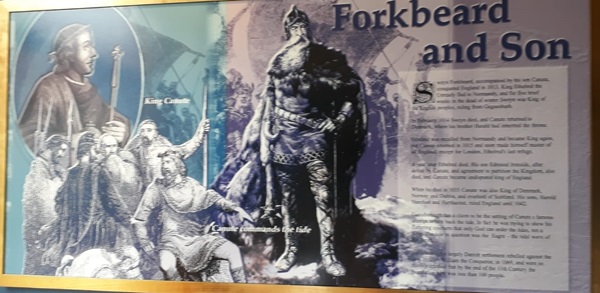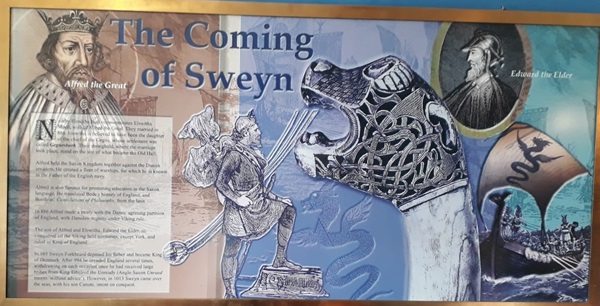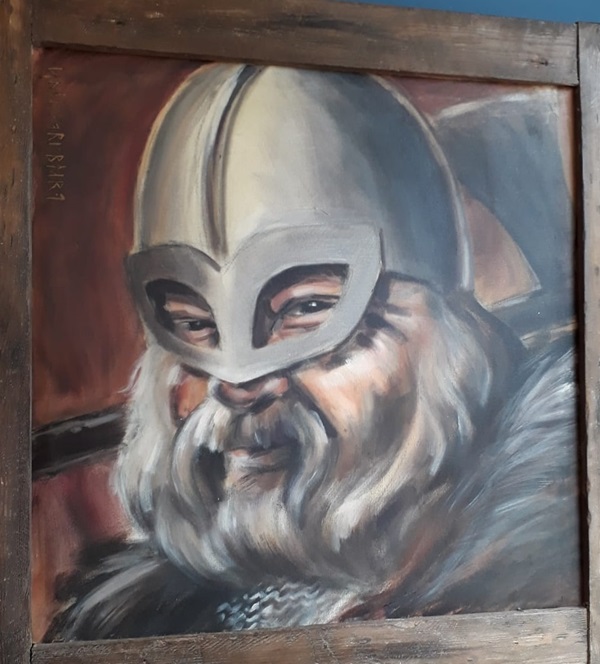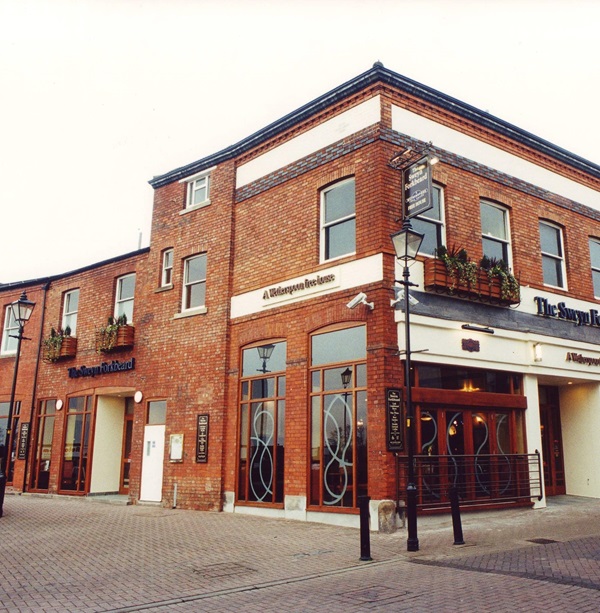Named after the early 11th-century king of Denmark who set out to conquer England from Gainsborough – where he was later murdered. In 1013, Sweyn Forkbeard sailed up the River Trent and camped his armies at Gainsborough. Leaving his son Canute in charge here, he proceeded to conquer the country. However, a few weeks after his arrival, Sweyn was murdered at Gainsborough, in the early part of 1014.
Illustrations and text about Forkbeard and son.

The text reads: Sweyn Forkbeard, accompanied by his son Canute, conquered England in 1013. King Ethelred the Unready fled to Normandy, and for five brief weeks in the dead of winter Sweyn was king of the English peoples, ruling from Gegnesburh.
In February 1014 Sweyn died, and Canute returned to Denmark, where his brother Harald had inherited the throne.
Ethelred was recalled from Normandy and became King again, but Canute returned in 1015 and soon made himself master of all England, except for London, Ethelred’s last refuge.
A year later Ethelred died. His son Edmund Ironside, after defeat by Canute, and agreement to partition the Kingdom, also died, and Canute became undisputed king of England.
When he died in 1035 Canute was also King of Denmark, Norway and Dublin, and overlord of Scotland. His sons, Harold and Harefoot and Harthacnut, ruled England until 1042.
Gainsborough has a claim to be the setting of Canute’s famous attempt to turn back the tide. In fact, he was trying to show his flattering courtiers that only God can order the tides, not a King. The tide in question was the Eagre – the tidal wave of the Trent.
Gainsborough’s largely Danish settlement rebelled against the new invader, William the Conqueror, in 1069, and were so harshly crushed that by the end of the 11th century the population here was less than 100 people.
Illustrations and text about the coming of Sweyn Forkbeard.

The text reads: Nearby Elswitha Hall commemorates Elswitha Mucil, wife of Alfred the Great. They married in 868. Elswitha is believed to have been the daughter of the chief of the Gegns, whose settlement was called Gegnesburh. Their stronghold, where the marriage took place, stood on the site of what became the Old Hall.
Alfred held the Saxon Kingdom together against the Danish invaders. He created a fleet of warships, for which he is known as the Father of the English navy.
Alfred is also famous for promoting education in the Saxon language. He translated Bede’s history of England, and Boethius’ Consolations of Philosophy, form the Latin.
In 886 Alfred made a treaty with the Danes, agreeing partition of England with Danelaw regions under Viking rule.
The son of Alfred and Elswitha, Edward the Elder, re-conquered all the Viking held territories, except York, and ruled as King of England.
A painting and text about Forkbeard.

The text reads: In 1013 Sweyn Forkbeard King of Denmark, sailed up the River Trent and camped his armies at Gainsborough. Leaving his son Canute in charge he proceeded to conquer the country.
This portrait is one of a series of paintings by the artist Tony Novak, that celebrate Gainsborough’s historical past. From the Viking longboat landings and examples of their handcrafter culture to an abstract representation of the Gainsborough’s contribution to the bicycle industry.
External photograph of the building – main entrance.

If you have information on the history of this pub, then we’d like you to share it with us. Please e-mail all information to: pubhistories@jdwetherspoon.co.uk